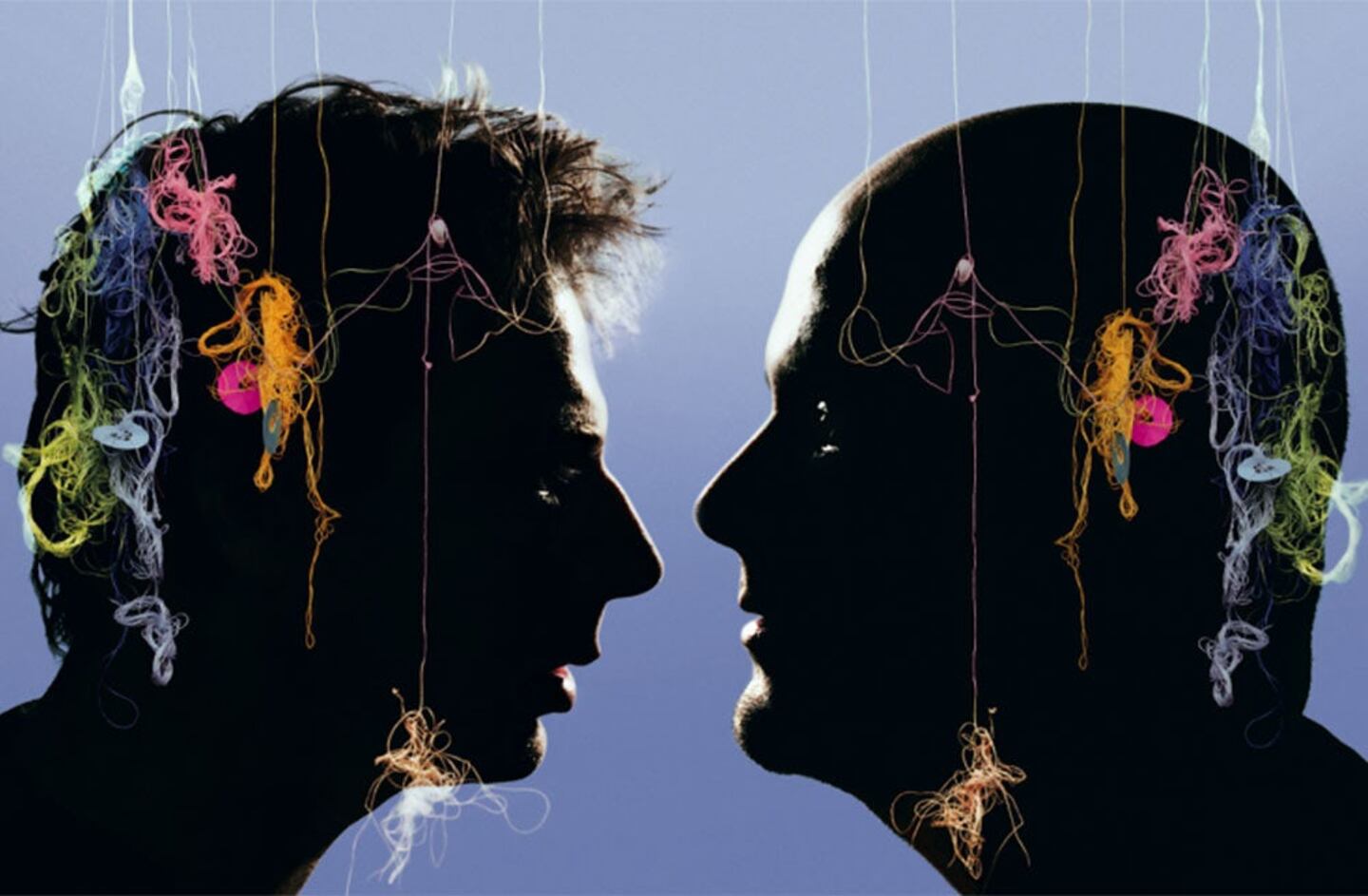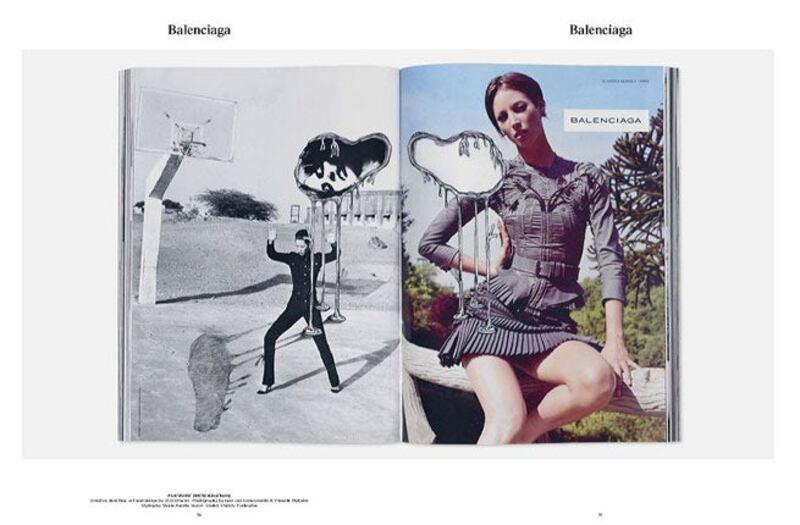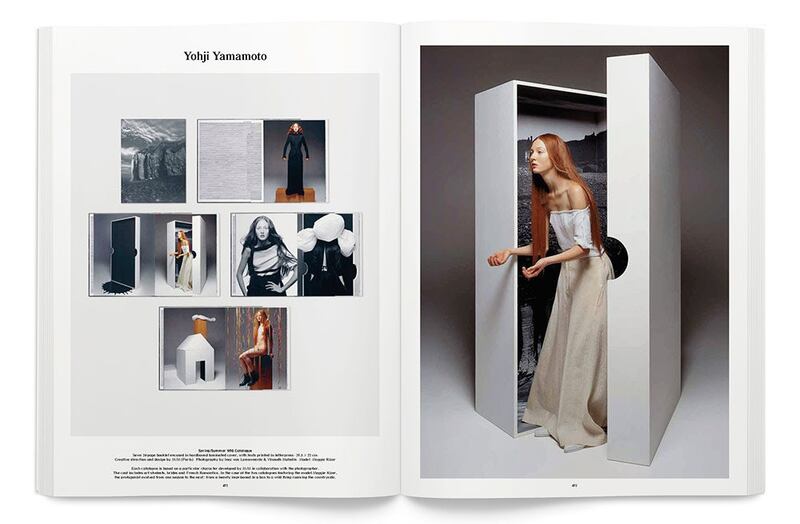
The Business of Fashion
Agenda-setting intelligence, analysis and advice for the global fashion community.

Agenda-setting intelligence, analysis and advice for the global fashion community.

PARIS, France — One morning in the summer of 2001, Christy Turlington found herself in a less than enviable position. It was at the Parc des Buttes-Chaumont, north-east of Paris, where Turlington, clad in heels and a pantsuit by Nicolas Ghesquière, could no longer take it and decided to confront her demon, a disembodied head that had been mercilessly following her around, its ear-shaped shadow doubling the supermodel's plight from below.
And so there, on a basketball court, we see Turlington, arms raised, in a stance vaguely reminiscent of martial arts or voodoo — part surrender, part ready-to-attack. Incidentally, her pose highlights the razor-sharp lines of her chic jacket and trousers, effectively becoming a modern sign, lamppost or letter — an “X” of sorts — its slim, urgent contour perfectly in sync with the zeitgeist of what she's wearing. Captured in black and white, the bizarre tableau became the advertising campaign for that year's Balenciaga Autumn/Winter collection, designed by Ghesquière.

Christy Turlington for Balenciaga | Source: M to M of M/M (Paris)
As Mathias Augustyniak tells it, the image, which thirteen years later has lost none of its confounding, haunting effect, is as naturalistic as it is manufactured. "Even if it's very surreal, it is also very real, because what you see in that image is, in a way, exactly what was happening in the heads of all the persons involved in that brand at the time."
ADVERTISEMENT
Augustyniak is half of the graphic design duo known as M/M (Paris), whose studio has produced some of our time's most indelible, idiosyncratic imagery in music, art and fashion, helping to shape, along the way, the visual culture — from pop to high — of the last two decades. To Augustyniak and his professional partner Michael Amzalag, the world consists of signs and images. Sitting in their unassuming office, a stone's throw away from the Canal St. Martin in Paris' 10th arrondissement, Augustyniak points at the table in front of him and says, "I call this an image because it looks like a three-dimensional sign, rather than a table."
In fact, Amzalag and Augustyniak founded M/M (Paris) in 1992 precisely to propagate that expanded definition of what an image could be. "We decided to create a graphic design studio to be able to work on many different aspects of what an image could be today. Whether it's a flat image, a poster, a moving image or a three-dimensional image, like a table," says Augustyniak. But far beyond merely producing memorable pictures, the duo went on to create an instantly recognisable visual vocabulary that's all their own — anti-sleek, seemingly illogical, complex, at once supremely articulated and raw, and invariably employing a diverse range of media.
For a client list that encompasses artists, designers, magazines, museums and musicians — including, famously, Madonna and Björk, whose Vespertine album cover put M/M (Paris) on the map — the pair has designed books, posters, album covers, theatre sets, and entire typographic alphabets. They have also art directed numerous advertising campaigns for fashion brands from Calvin Klein and Stella McCartney to Jil Sander and Givenchy (for whom they design Riccardo Tisci's hyper-chic fashion show invites). And following J.W. Anderson's appointment as creative director at Loewe, M/M (Paris) is working closely with the young designer on the rebranding of the Madrid-based luxury house.
The Christy Turlington image is in fact a collage, and the halo of what appears to be mercury dripping down from that floating head, a hand-drawn illustration. It exemplifies the irrevocable way in which M/M (Paris) changed the way we think of fashion images. As Augustyniak explains, "At a certain moment, a fashion picture was simply a fashion photograph. What we changed and added to that, is that we produced a fashion image, using all elements at our disposal to make an image more than just the photography." Those elements often include superimposition of images, hand-drawn illustration, and the invention of original, at times child-like typography. In the end, the photograph is all but rendered unrecognisable.
"What sets us apart from most other art directors in fashion is that we tend not to work with referenced images,” Amzalag says of another trademark of M/M (Paris). “We create our own images, the references we use come out of our own conversations."
Attempting to describe their function in fashion’s ecosystem, Augustyniak says, "We're documentarians. Our job is to produce images that bring out some essential, meaningful facts about someone else's creative universe. To do this we may use surrealist collage, drawings or plain photography. Because any and all tools are valid to bring out the information we are seeking to unearth, so we use the whole palette of visual language, from typography to hyperrealism to surrealism."
Augustyniak was born in a small town in the south of France, the son of art teachers. As a kid he dreamt of being an “engineer of leisure time,” a harbinger of the way he and Amzalag work today, where their professional life fits no easy description and is inseparable from their personal preoccupations and philosophies. Meanwhile, a true child of the revolution, Amzalag was born amidst the tumultuous student and worker-led upheavals of Paris 1968. As a result of the general strikes that paralysed the capital, the city’s hospitals were closed and his Moroccan-born parents had to rush to the suburbs to give birth.
The two grew up in the fertile cultural climate of “post-68” France. "We were born into an era when in France culture was everywhere, there was no filter between high culture and the mass culture," says Augustyniak, adding that, as a result of this fervent, interdisciplinary environment, "we were excited by the idea of how to produce culture on any level."
ADVERTISEMENT
They met as students at Paris’ École Nationale Supérieure des Arts Décoratifs in Paris in 1988. What drew them together instantly, Amzalag says, was "the possibility of many conversations, which we saw from the start. It was very obvious that we were coming from very different backgrounds, and that we were looking at different things and had different interests, in a way we were opposites. But at the same time there was a common ground, there were a lot of things that we could discuss, even if it was from a different point of view — music, design, art. And there was a mutual feeling that we would both get richer through this dialogue, and learn from each other."
Both Amzalag and Augustyniak admit having been interested in fashion long before working in the field. About the time, Amzalag says, "The ‘80s in France were infatuated with fashion, with designers like Gaultier and Mugler. It was normal for someone like Jean-Paul Goude to do an ad for Citroen and make an appearance at a store. It was part of popular culture."
While M/M (Paris)'s first clients came from the world of music, the pair soon quite naturally segued into fashion, the combined result of having an aesthetic sensibility that was right for the time, lucky connections to people who recognised their talent (notably Marc Ascoli and Irene Silvagni) and simply going for it.
As the fashion landscape was changing Amzalag and Augustyniak saw an opportunity that fit their way of thinking and working. Augustyniak recalls, "The idea of using an art director came from Japan. People in Japan were very interested in clothes but they also knew the power of images. Rei Kawakubo, from the beginning, was making clothes but promoting them with powerful images. That didn't exist so much in France when we started out, here it was mostly just about fancy, glamorous clothes. It was Japanese designers that introduced the idea of conceptual, idea-driven fashion in France, and it had a huge influence. It also helped us enter the world of fashion, because when you are trained as a graphic designer and went to art school, you tend to think about what you do."
Their big break in fashion was an assignment art directing the advertising campaign for the international launch of Y's, the original label of Japanese designer Yohji Yamamoto, with whom the duo would work for 14 seasons, leading to jobs for a host of other fashion industry clients.

Yohji Yamamoto 1998 catalogue | Source: M to M of M/M (Paris)
Highly intellectual and rigorous in their approach, M/M (Paris) regard their work as an evolving documentation, and a serious responsibility. Augustyniak says this is a direct result of their traditional academic backgrounds. "As students we were taught that the longer you take and the more information you gather the better [what you produce] will be."
The often playful, haphazard quality of their visual vocabulary belies the painstaking research that goes into its creation. The seeming arbitrariness of their images is, in fact, meticulously studied. Indeed, Augustyniak says there are two key elements to their creative process: "There is an intuition, a moment of 'Ok, that's how we feel.' And then ‘How do we execute this intuition,’ which involves giving structure to that creative idea, figuring out the rules and parameters it will take to make it reality."
ADVERTISEMENT
Accordingly, for Amzalag and Augustyniak, every commercial assignment is part of a larger project, a vehicle to push and expand their semiotic universe. The images they produce are single-moment takes of a series of circumstances, as much a reflection of themselves as of the brand or subject in question. This may explain their schematic, work-in-progress quality. Augustyniak says "Our approach is very documentary, in that in everything we do, we are trying to bring out the truth of the project we're working with on."
Their singular approach to fashion may also account for the variety and idiosyncrasy of their early to mid-career output for fashion brands. Says Amzalag, "Every time, we were thinking about how to make what we had seen on the runway different. It was never about literally translating the runway into a campaign. It was about reinterpreting it. 'How can you turn this into something else to make it even more exciting?'”
Amzalag and Augustyniak are known for the unusually intense relationships they forge with many of their clients. "Being in constant contact with the people we are working with is very important to us. I think it is one of the keys to why our images are different," says Augustyniak, "I need to be able to have the right discussion with the person in order for me not to superimpose a preconceived image of that person on them."
Indeed, the way its principals tell it, verbal communication is at the heart of M/M (Paris)’s practise. With every assignment, whether it's for a fashion house or different kind of client, the pair uses dialogue to excavate for meaning, symbols, and clues. According to Augustyniak, even the image of Christy Turlington at the Buttes-Chaumont is nothing more and nothing less than "the result of our discussion" with the house Balenciaga, and with Ghesquière, its creative director at the time.
Regarding their milestone collaboration with the iconic brand, Amzalag says, “When we met Nicolas it was the first time that we were working with a designer from our generation, who had a similar background and way of thinking as us. We shared the same cultural references.” Because of this symbiotic and friendly rapport (Ghesquière was also a neighbour of Amzalag), "Balenciaga gave us an opportunity to challenge ourselves and go way further than we had [with previous fashion clients]. With every new image we were pushing the envelope."
The collaboration came to an end after several seasons, due to what is a common arc in the industry, according to Amzalag. "There is a pattern that when the images become too powerful, the designer becomes suspicious and ends the collaboration. It doesn't just happen to us, it was the same when Tom Ford's Gucci stopped working with Mario Testino, which to this date makes no sense."
But things have changed, according to the designers. Amzalag says, “The freedom we had [working with Yamamoto] is absolutely inconceivable today." Augustyniak adds, "We had time to produce things then. It was so involved it was almost like producing a small movie. We'd write a scenario and then invest a lot of time executing it, casting the right people, so at the end you would have a product that was at the level of the scenario we had envisioned. It is very different now."
Given their belief that it is new relationships that keep their language evolving, it is not surprising that Amzalag and Augustyniak seem thrilled to be working with J.W. Anderson. "It's yet another configuration, a very exciting one." Adds Amzalag, "It's another generation." Augustyniak: "We are now dealing with us being the past." Amzalag: "Our work is now part of his references."
As for those aiming to following in their footsteps, "Study as much as you can," says Augustyniak. Amzalag expounds: "Students often don't realise that the time they have in school is the only time they have left for experiments, because once they're out in the real world there's no time left for experimentation, because all of your time is taken up by production, unless you can define your production time as time for experiments. Which is what we've been trying to do for 21 years. But it’s a constant fight, because you're constantly confronted by reality."
For M/M (Paris), the battle seems to be working. Augustyniak sounds content, motivated and like he’s achieved his childhood dream to be an “engineer of leisure time.”
"The versatility and complexity of our work tends to make it mesmerising and at the same time disturbing somehow. This is what we set out to do, to create a world with its complexity.”
Discover the most exciting career opportunities now available on BoF Careers — including jobs from Hugo Boss, Banana Republic and House of CB.
To provide actionable insights and inspiration on how fashion and retail industries can further embed diversity, equity and inclusion in the workplace and business strategies today, BoF Careers co-hosted a panel discussion with The Outsiders Perspective. Now, BoF shares key learnings from the panel.
A US regulator has banned most uses of the clauses, which started as a way for fashion companies to prevent senior executives from walking off with trade secrets, but have become a standard retention tool.
Check out this week’s new partners and openings on BoF Careers, the global marketplace for fashion talent.